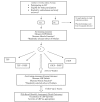Rationale, design, and protocol for the prevention of low back pain in the military (POLM) trial (NCT00373009)
- PMID: 17868436
- PMCID: PMC2034557
- DOI: 10.1186/1471-2474-8-92
Rationale, design, and protocol for the prevention of low back pain in the military (POLM) trial (NCT00373009)
Abstract
Background: There are few effective strategies reported for the primary prevention of low back pain (LBP). Core stabilization exercises targeting the deep abdominal and trunk musculature and psychosocial education programs addressing patient beliefs and coping styles represent the current best evidence for secondary prevention of low back pain. However, these programs have not been widely tested to determine if they are effective at preventing the primary onset and/or severity of LBP. The purpose of this cluster randomized clinical trial is to determine if a combined core stabilization exercise and education program is effective in preventing the onset and/or severity of LBP. The effect of the combined program will be compared to three other standard programs.
Methods/design: Consecutive Soldiers participating in advanced individual training (AIT) will be screened for eligibility requirements and consented to study participation, as appropriate. Companies of Soldiers will be randomly assigned to receive the following standard prevention programs; a core stabilization exercise program (CSEP) alone, a CSEP with a psychosocial education (PSEP), a traditional exercise (TEP), or a TEP with a PSEP. Proximal outcome measures will be assessed at the conclusion of AIT (a 12 week training period) and include imaging of deep lumbar musculature using real-time ultrasound imaging and beliefs about LBP by self-report questionnaire. We are hypothesizing that Soldiers receiving the CSEP will have improved thickness of selected deep lumbar musculature (transversus abdominus, multifidi, and erector spinae muscles). We are also hypothesizing that Soldiers receiving the PSEP will have improved beliefs about the management of LBP. After AIT, Soldiers will be followed monthly to measure the distal outcomes of LBP occurrence and severity. This information will be collected during the subsequent 2 years following completion of AIT using a web-based data entry system. Soldiers will receive a monthly email that queries whether any LBP was experienced in the previous calendar month. Soldiers reporting LBP will enter episode-specific data related to pain intensity, pain-related disability, fear-avoidance beliefs, and pain catastrophizing. We are hypothesizing that Soldiers receiving the CSEP and PSEP will report the longest duration to first episode of LBP, the lowest frequency of LBP, and the lowest severity of LBP episodes. Statistical comparisons will be made between each of the randomly assigned prevention programs to test our hypotheses related to determining which of the 4 programs is most effective.
Discussion: We have presented the design and protocol for the POLM trial. Completion of this trial will provide important information on how to effectively train Soldiers for the prevention of LBP.
Trial registration: ClinicalTrials.gov NCT00373009.
Figures
References
-
- Andersson HI, Ejlertsson G, Leden I, Rosenberg C. Chronic pain in a geographically defined general population: studies of differences in age, gender, social class, and pain localization. Clin J Pain. 1993;9:174–182. - PubMed
Publication types
MeSH terms
Associated data
LinkOut - more resources
Full Text Sources
Medical
Miscellaneous


